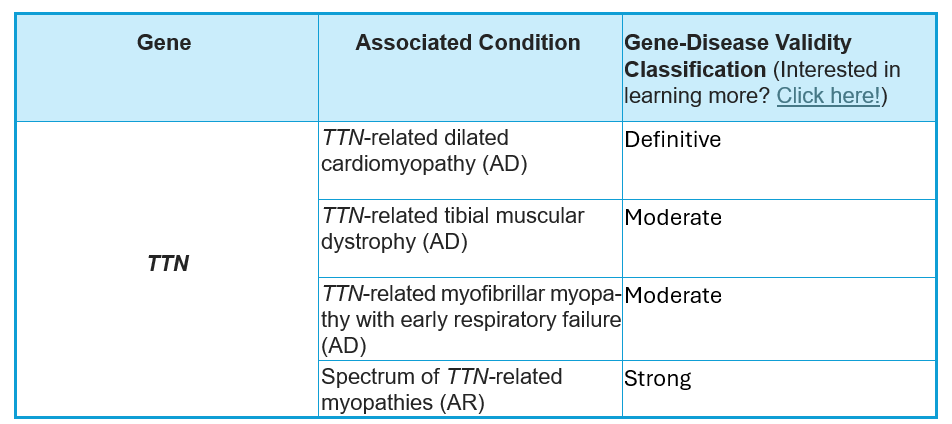 Welcome to the Gene Scene! Each week, we will explore a gene from the ACMG Secondary Findings list—genes identified by the American College of Medical Genetics and Genomics as having clear, actionable health implications. These genes are included because they’re linked to serious but preventable or manageable conditions when identified early. Here, we focus on the condition that led to the gene’s inclusion on the list, providing clear, relevant information that supports your clinic. To subscribe to the Gene Scene, contact your local GSL or send a request to info@ambrygen.com.
Welcome to the Gene Scene! Each week, we will explore a gene from the ACMG Secondary Findings list—genes identified by the American College of Medical Genetics and Genomics as having clear, actionable health implications. These genes are included because they’re linked to serious but preventable or manageable conditions when identified early. Here, we focus on the condition that led to the gene’s inclusion on the list, providing clear, relevant information that supports your clinic. To subscribe to the Gene Scene, contact your local GSL or send a request to info@ambrygen.com.
To access the Gene Scene archives, visit our blog.
Clinical Phenotype Summary:
The TTN gene (NM_003319.4, N2B isoform), which contains 190 coding exons and is located on chromosome 2q31.2, encodes the titin protein. Pathogenic variants in this gene are known to cause TTN-related familial dilated cardiomyopathy (DCM), TTN-related tibial muscular dystrophy (TMD), and TTN-related myofibrillar myopathy (MFM) with early respiratory failure, which are inherited in an autosomal dominant fashion, as well as a spectrum of TTN-related myopathies which are inherited in an autosomal recessive fashion.
TTN-related DCM is characterized by:
• Ventricular chamber enlargement
• Systolic dysfunction with normal left ventricular wall thickness
TTN-related TMD is characterized by:
• Late-onset distal myopathy
• Hypotonia and atrophy frequently restricted to the anterior lower leg
• Cardiomyopathy has not been diagnosed in patients with TMD
TTN-related MFM is characterized by:
• Adult-onset progressive weakness of proximal and distal muscles
• Respiratory insufficiency
Recessive TTN-related myopathies are characterized by:
• Muscle weakness
• Atrophy
• Gait disturbances
• Frequent falls
• Exercise intolerance
• Congenital contractures, respiratory insufficiency, and abnormal muscle biopsy results have been reported in a minority of patients
Unique Considerations:
Several factors complicate the interpretation of genetic variants in the TTN gene including reduced penetrance, age-dependent expression, multiple protein isoforms, and genetic heterogeneity. The interpretation of missense variants in TTN is particularly difficult without supporting functional studies and/or strong co-segregation analysis.
The 190 coding exons that encode the titin protein can be further identified by region. The N-terminus is anchored in the Z-disc (coding exons 1 through 13) and is followed by the near Z-disc and near Z-disc/I-band region (coding exons 14-26). The bulk of the protein spans the I-bands (coding exons 27 through 78) and A-bands (coding exons 79 through 184), and the C-terminus is located in the M-line (coding exons 185 through 190). Some alterations may be associated with autosomal recessive titinopathy and have an unknown association with autosomal dominant cardiomyopathy. The variant details paragraph will include information on the variant's position in titin and associated condition(s).
Clinical Resources:
Understanding your Secondary Findings Result
Clinician Management Resources and Understanding Your Results for Positive Cardiovascular Results
Ambry Knows Genes:
Scientific Presentations:
Knocking Out a Titan: Assessing the Effect of Truncating TTN Alterations in a Large Clinical Cohort. (ACMG, 2017)
Scientific Posters:
Wrestling the Giant: Experience with TTN Testing for Cardiomyopathies American College of Medical Genetics (ACMG, 2017)
Citations:
• Herman DS et al. N Engl J Med, 2012 Feb;366:619-28 PMID: 22335739
• Roberts AM et al. Sci Transl Med, 2015 Jan;7:270ra6 PMID: 25589632
• Schafer S et al. Nat Genet, 2017 01;49:46-53 PMID: 27869827
• Akhtar MM et al. Circ Heart Fail, 2020 Oct;13:e006832 PMID: 32964742
• Massier M et al. Clin Genet, 2025 Apr;107:425-433 PMID: 39844436
• Vatta M et al. Circ Genom Precis Med, 2025 Feb [Online ahead of print] PMID: 39968638
• Hackman P et al. Am J Hum Genet, 2002 Sep;71:492-500 PMID: 12145747
• Carmignac V et al. Ann Neurol, 2007 Apr;61:340-51 PMID: 17444505
• Ceyhan-Birsoy O et al. Neurology, 2013 Oct;81:1205-14 PMID: 23975875
• Chauveau C et al. Hum Mol Genet, 2014 Feb;23:980-91 PMID: 24105469
• Evilä A et al. Ann Neurol, 2014 Feb;75:230-40 PMID: 24395473
• Savarese M et al. JAMA Neurol, 2018 May;75:557-565 PMID: 29435569
• Qi Y et al. Front Genet, 2022 Jan;13:1064474 [article]
• Kimura A. Circ J, 2011 May;75:1756-65 PMID: 21617319
• Norton N et al. Circ Cardiovasc Genet, 2013 Apr;6:144-53 PMID: 23418287
Ambry Genetics Gene-Disease Validity Scheme
Each week, we explore a gene from the ACMG Secondary Findings list—genes identified by the American College of Medical Genetics and Genomics as having clear, actionable health implications. These genes are included because they’re linked to serious but preventable or manageable conditions when identified early.
To learn more about the ACMG Secondary Findings list, click here.
To read all previous Gene Scene emails, click here.




